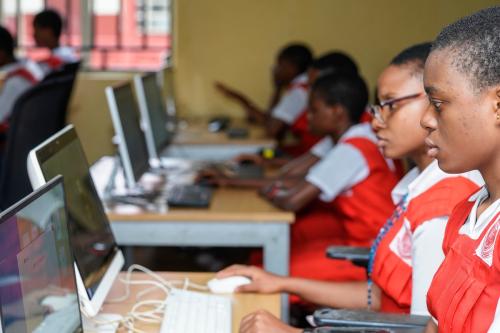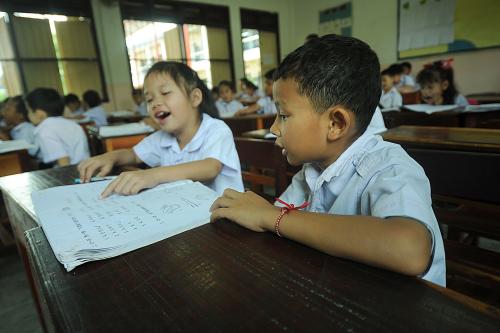A recent article in The Guardian caught my eye: “Report accuses government of increasing inequalities in developing countries by financing academies at the expense of state schools.” The report, conducted by the U.N. Committee on the Rights of the Child, was an attack on U.K. aid money being linked to private education providers since the rapid increase in such schools may be contributing to sub-standard education. In particular, they cited the U.K. government’s investments in the Nairobi-based and for-profit Bridge International Academies.
I’ve worked on private education extensively throughout my career and do not believe there is anything wrong with private schools, but in this particular case I couldn’t agree more. But to be clear, it’s the funding strategy that’s the problem.
Private schooling is on the rise in a number of poor countries, and Pakistan—where my education research is focused—is no exception. The majority of these schools are no longer the elite institutions of yore, but low-cost alternatives fighting for survival in a highly competitive environment. These schools have mushroomed in response to increased parental demand and poor public alternatives, but also to the greater availability of teachers in the local labor market.
More importantly, research increasingly demonstrates that there is absolutely nothing wrong with private schools. There’s a summary of this research available here; specific examples on India (more here) and Pakistan are also available.
Some key are takeaways from this research are:
- Private schools charge low fees (about $1 to$2 a month in Pakistan).
- The quality is almost certainly higher compared to government schools in the vicinity.
- At least in Pakistan, there is no significant segregation between public and private schools in terms of parental wealth, education, or caste.
- The most significant barrier to attendance in low-cost private schools is not cost—it’s distance. Put simply, there just aren’t enough of them around.
If there is a cheaper and better alternative to public schooling, shouldn’t we encourage children to shift and thus improve the quality of education for all?
Perhaps. But when the rubber from these well-intentioned aid policies hits the road of rural Pakistan, Kenya, or Ethiopia, a very different sort of model emerges. Instead of supporting private schooling, donors end up supporting private schools (or at best private school chains), which is an entirely different action with little theoretical backing. In fact, economic theory screams that governments and donors should almost never do that.
Donors say the problem is that the low-cost private school market is fragmented with no central authority that can be “contracted with.” No one has a good model on how to work with a competitive schooling sector with multiple small players—ironically, the precise market structure that, according to economics, leads to efficiency.
In reality, I suspect the problem goes deeper. Most low-cost private school owners don’t do well at donor conferences. They don’t know how to tell compelling human-interest stories about the good they do. But what they are excellent at is using local resources to ensure that their schools meet the expectations of demanding parents.
The problems with foreign aid financing private schools
The first is a problem of accountability. Public schools are accountable, through a democratic system, to citizens of the country. Private schools are accountable to the parents. And donor-funded private school chains are account to the donors. While both citizen-led accountability and direct accountability to parents have problems, they are grounded in centuries of experience. It’s unlikely that donors in a foreign land, some of whom can’t visit the schools they fund for security reasons, can do better than either citizens or parents.
The second is a problem of market structure. When one private school or private school chain receives preferential treatment and funding, without allowing other private schools to apply for the same funds, the donor is picking winners (remember Solyndra?). The need for private schools as an alternative to government schools is insufficient justification for donors to put their thumbs on the scale and tilt the balance of power towards a pre-identified entity.
Adjusting the strategy
In a recent experiment, my colleagues and I gathered direct proof for this assertion. We gave untied grants to low-cost private schools with a twist. In certain villages, we randomly selected a single private school for the grant. In others, we gave the grant to every private school in the village. Our preliminary results show that in villages where we gave the grant to a single school, the school benefitted enormously from an increase in enrollment. Where we gave the grant to multiple private schools, the enrollment increase was split among schools. But only in the villages where we gave the grant to every school did test-scores for children increase.
What happened? When a single private school receives the grant, knowing that the other schools cannot react due to a lack of funds, they engage in “customer poaching” to increase their profits at the expense of others. Some have argued that Uber’s recent fundraising is precisely such an effort to starve competitors of funding.
When you equally support all private schools, customer poaching does not work, and the only way to increase profits and generate returns is to increase the size of the market, either through higher overall enrollments or through new quality offerings.
The first strategy supports pre-identified private schools and concentrates market power. The second, by providing opportunities for all private schools, improves education for children.
Sure, some private school chains and schools are making positive impact and deserve the support they can get. But funding such schools creates the wrong institutional structures and are more likely to lead to disasters than successes (Greg Mortensen and 3 cups of tea, anyone?).
In general, the Government’s responsibility towards the education of children is two-fold:
- Alleviate the market constraints that hold back private schooling without favoring one school over the other—letting parents decide who succeeds and who does not.
- Support and improve public schools to provide an alternative because there will always be children who cannot enroll in private schools, either because they are too expensive or because they are too far away, or because they don’t offer the instruction “basket” that some parents want.
In short, foreign aid should play no part in supporting private schools rather than private schooling.



Commentary
Foreign aid should support private schooling, not private schools
June 29, 2016